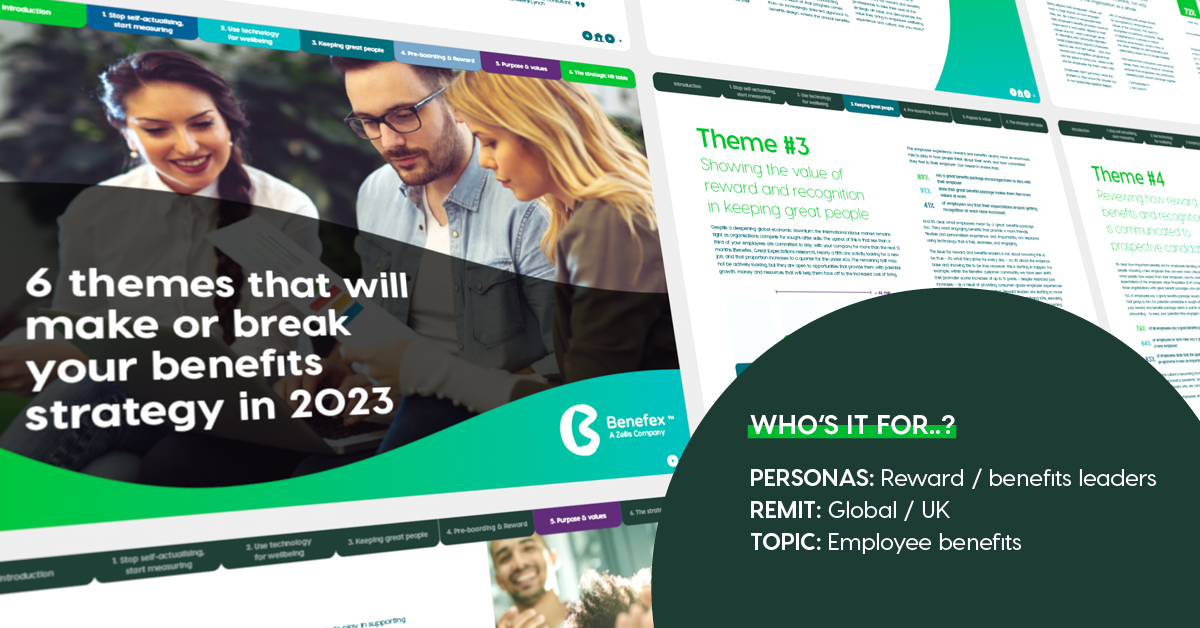
06th March 2023
Showing the value of your reward, benefits and recognition offering throughout the employee lifecycle

Benefits, reward and recognition have an increasingly important role to play in all stages of the employee lifecycle – from the hiring process through to onboarding, engagement and retention. So how can you show the value of everything you do for employees?
Despite a deepening global economic downturn, the international labour market remains tight as organisations compete for sought-after skills. The upshot of this is that less than a third of your employees are committed to stay with your company for more than the next 12 months (Great Expectations). Nearly a fifth are actively looking for a new job, and that proportion increases to a quarter for the under 40s. The remaining half may not be actively looking, but they are open to opportunities that provide them with potential growth, money and resources that will help them face off to the increased cost of living.
In such a competitive labour market, showing the contribution of benefits, recognition and reward to the wider employee experience is becoming a critical differentiator and we predict that it will become even more imperative in 2023. Reward and benefit leaders already know the benefits of investing in better employee experiences – on engagement, retention, acquisition and business growth – but showing it can be more difficult. The challenge that reward and benefit leaders face is not just to communicate the value of everything to do for employees; they must prove the value of benefits, reward and recognition to the organisation.
Employee retention and engagement
The employee experience, reward and benefits clearly have an enormous role to play in how people think about their work and how committed they feel to their employer. Our research shows that 89% of employees say a great benefits package encourages them to stay with their employer and 91% state that a great benefits package makes them feel more valued at work. And it’s clear what employees mean by a ‘great’ benefits package too – they want engaging benefits that provide a more friendly, flexible and personalised experience, and importantly, are deployed using technology that is fast, seamless and engaging.
79% of employees report that the employee experience is more important than it was 12 months ago and , along with flexible working, employees believe that the single most effective way for employers to improve the employee experience is to provide relevant benefits that align with their wants and needs. However, with only 34% of employees agreeing that their benefits package aligns with what’s important to them – this is a key area of opportunity for reward and benefit leaders to address.
Attracting new and prospective employees
It’s clear how important benefits are for employees deciding whether to stay with employer; but for people choosing a new employer they are even more critical. There’s been a generational shift in what people now expect from their employers, and it’s created a new benchmark for candidate expectations of the Employee Value Proposition (EVP). In fact, 76% of employees say a great benefits package would attract them to a new employer (this jumps to 84% for potential candidates in sought-after technology roles). Employees are now actively seeking out those organisations with great benefit packages, who prioritise their values and wellbeing.
Communicating the value of everything you do
When it comes to championing benefits, wellbeing, and the wider employee experience, benefits leaders that understand – and can evidence – the role benefits and recognition play in the employee Net Promoter Score (eNPS) can gain an advantage. By developing a robust and creative strategy, which puts the employee experience at the centre and embeds measurement and evaluation throughout, organisations can really start to use benefits as a strategic lever, improving both talent retention and acquisition.
To deliver on these growing employee expectations, your reward and benefits package needs to pull its weight – from first contact, to offer, to onboarding – to keep your potential hires engaged and help instil the organisational culture. A new joiner’s first experiences with their employer are vital in shaping culture. However, cultural information is fragmented – some of it might be buried on the intranet; some of it might be delivered during the induction progress; some of it might be communicated during recruitment and so on – but there’s usually no specific place where it can all be brought together for prospective and existing employees.
Beginning prior to their official start date, an integrated onboarding process should allow new hires to connect with their employee benefits, and access useful information and targeted content. For all employees, it should be easy to get a full understanding of everything the organisation does for them so that each individual feels that they’re at the centre of their own, personalised employee experience.
What next in 2023?
This joined-up experience is starting to happen with platforms built around culture, wellbeing, and benefits that give visibility – for employees new and old – to the messaging from leaders across the organisation about what their culture means, in one easily accessible place.
In our latest report, we delve into the six themes that will make or break your benefits strategy in 2023. Download your copy here.

